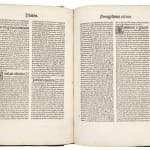



Perez de Valentia, Jacob
First edition of a cosmographically-relevant Spanish work, apparently the first published in Spain to adhere to the Ptolemaic theory of the world, printed at the first press established Valencia (Spain), in a fascinating strictly contemporary Spanish “Mudejar” style binding.
Further images
Two volumes, median folio (336 x 235mm). 397 ff. (of 400, without three blanks). Contemporary Spanish brown blindstamped morocco, clasps and brass catchplates, edges saffron, remains of paper label on spine, formerly chained, lacking one clasp, worming and scrapes to boards, corners chipped, one spine panel gone. Some dampstaining and spotting mostly at ends, some worming in text, a repaired tear affecting text on one leaf.
The defense of the Ptolemaic model was a groundbreaking novelty for the development of European cartography, this was also of course the case for Spain, particularly because it´s postulates allowed explorers as Columbus to believe in the feasibility of voyages employing different routes; this text includes “the first outright recognition of the clash between the physics of the Aristotelian scholastics and the mathematical geography of Ptolemy derived from astronomy” (Mayer and Haase), defending the rationality of the Ptolemaic model in light of discoveries by explorers and navigators.
Jacob Perez of Valencia (1408-1490) was an Augustinian theologian who wrote several commentaries on books of the Bible; this one engages both with Christian sources and rabbinical literature on the Psalms. Perez’s discussion of the world of the Psalms blends Biblical citations with Ptolemaic geography to explain the locations of places like the Garden of Eden in light of scientific knowledge. This copy is the issue printed entirely by Cordoba, matching the BMC collation.
“No work published during the Renaissance was to so revolutionize the science of mathematical geography. Known in Portugal from at least 1484, and in all probability in Spain at the time of the Juntas, Ptolemy´s work was apparently ignored by the Spanish cosmographers, who do not seem to have been aware of the incompatibility between its basic theoretical tenets and the pseudo-aristotelian doctrina of Paul de Burgos, which they so obediently followed. In contrast to the pseudo-aristotelian theory of late medieval scholastic science, according to which the eart-oikumene emerged like an island out of the water, Ptolemy declared that ´the continuous surface of the earth and of the seas forms one sphere, whose centre is the same as that of the celestial bodies´. Columbus seems to have followed this view himself, for according to Las Casas, ´… since all the water and the earth in the world made up one sphere […] Columbus believed that it was possible to circumnavigate it from east to west´…
A recognition of the clash between the two theories of the relationship between earth and water, the pseudo-aristotelian on the one hand, and the Ptolemaic on the other, appears clearly in the work of a Spaniard, Jacob Perez de Valencia. In his Commentary on the Psalms, published in Valencia in 1484, he comes out resolutely in favour of the Ptolemaic theory, as oppsed to the pseudo-aristotelian. ´… for some imagine´, he wrote, ´that the earth lies in the water like a light ball, or like an apple in a basin fully of water, of which only the summit appears above the water […]. This view is obviously irrational´… ´the seas are no more than gatherings together of the waters in the depths of valleys between the mountains […] the Ocean does not surround the earth, as is commonly thought…
There is nothing to show that Perez´ Ptolemaic critique of the pseudo-aristotelian doctrine was known in Portugal in the fifteenth century, nor did the Spanish cosmographers of the Juntas of 1486-7 and of 1491 seem to have been aware of it in view of their reiterated defense of Paul de Burgos, but the critique did indeed exist and it came from a thinker inside the Iberian peninsula. It is symptomatic of a changing climate of opinion” (Randles, W. G. L. “The Evaluation of Columbus’ ‘India’ Project by Portuguese and Spanish Cosmographers in the Light of the Geographical Science of the Period.” Imago Mundi 42 (1990): 50–64).
“The Lehman map copies the innovative orientation of the Mauro and Este maps, yet it implies familiarity with current quattrocento theories that placed the location of Eden in the south rather that the East. This location appears in the legends written on the Este map, and is also put forth in the writings of the fifteenth-century theologian Jacob Perez de Valencia. The purpose of Perez´ treatise Commentaria in Psalmos was to integrate the content of Ptolemy´s Geographica with biblical text. Using Psalm 103 as a base, he wrote about the structure of the medieval oikoumene in terms of its mountains and valleys. Perez´ description of the mountains of the earth is taken from Ptolemy. Accordingly, he listed five important chains bordering the seas and oceans: one each at the northern and southern edges of the earth, and three others edging the Indian Ocean and Mediterranean Sea. He postulated that Eden was located at the top of the “Mountain of the Moon”. The highest point of the range bordering Africa and extending to the southern shore of the Indian Ocean…” (Dixon, Laurinda S. “Giovanni Di Paolo’s Cosmology.” The Art Bulletin 67, no. 4 (1985): 604–13).
HR 12597; BMC X 17; IBE 4416; Goff P-276; ISTC ip00276000. See Reinhold Meyer and Wolfgang Haase, European Images of the Americas and the Classical Tradition (2011), pp.41-3.
Provenance: from the collection of Elaine and Alexandre Rosenberg.
Join our mailing list
* denotes required fields
We will process the personal data you have supplied in accordance with our privacy policy (available on request). You can unsubscribe or change your preferences at any time by clicking the link in our emails.




